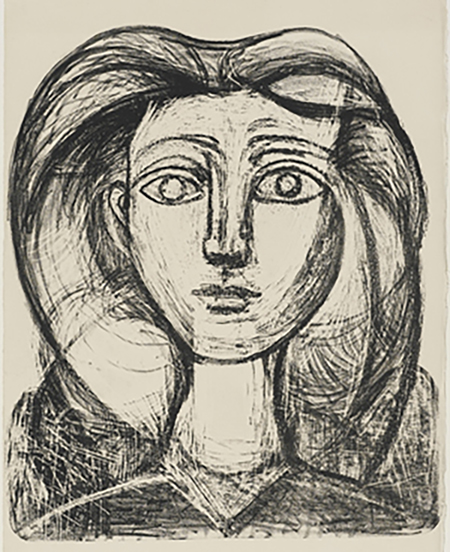
Pablo Picasso had a restless creativity. Throughout his life, he also had plenty of energy to explore new mediums and see what they could do for him. “States of Mind: Picasso Lithographs 1945–1960” culls some 80 examples from its own remarkable collection of some 700 Picasso prints. These were made during a period when the artist was particularly keen on the experimentation possible in the medium, and also on making a record of his own process. This can be done quite easily with lithography, since it is a “flat” process — the image does not eat into the plate, like an etching. Using a special type of crayon or ink, the image is drawn or transferred onto the litho stone or plate, and this image can be redrawn and scraped to make successive prints.
Picasso had tried prints early in his career, but in 1945 he paid a visit to the Mourlot Frères lithography shop in Paris, and a meeting with director Fernand Mourlot would lead to a long and prolific collaboration. The artist worked with their printers to experiment with grattage — fusing collage with mixed media — and often made prints at several stages of the process. For the exhibition, the museum’s associate curator Emily A. Beeny has made a deft selection of such stages, plus the final work in a progression which is especially telling in the life of a Picasso litho.
Several times he goes from a sketch and more complex image to a simplified one. Take the portrait “Long-Haired Young Girl” (1945), where three stages are shown. The first is a working sketch, showing a woman with sparkling large eyes and bouffant hairdo — probably his longtime companion, Francoise Gilot) The second was made three days later, and now the face has become larger and the pupils removed. In the final print, pulled two and a half weeks after the first, the face has become highly simplified, with head and hair mainly outlines.
While many of the lithos are in black-and-white, Picasso occasionally also worked with color, such as in “Still Life with Three Apples” (1945), shown in three versions. Three apples have been placed next to a vase. The final one is again a simple line drawing, but with three solid patches of color behind the objects. This one seems almost un-Picasso-like in its cheerful buoyancy.
The artist did try more complex compositions, and he also made reference to the work of other artists he admired. A series of lithos were inspired by Eugène Delacroix’s famous painting “Women of Algiers,” a highly romanticized rendering of Algerian women in palatial quarters in the Orientalist tradition. Picasso’s prints are almost Post-Modern as they juggle different artistic renderings of women in a tight architectural space. On the left is a large woman with a wraparound headdress and bared breasts. One to the right is a blocky sculptural shape, and another in the background is rather like a Matisse cut-out. The reference to Matisse was not accidental, as that artist had died just the year before, and Picasso acknowledged him as a peer.
Published courtesy of ArtScene ©2016
